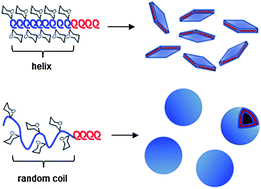Glycopolypeptide conformations in bioactive block copolymer assemblies influence their nanoscale morphology†
Abstract
We describe the preparation and

* Corresponding authors
a Department of Chemistry and Biochemistry, University of California, Los Angeles, CA 90095, USA
b
Department of Bioengineering, University of California, Los Angeles, CA 90095, USA
E-mail:
demingt@seas.ucla.edu
Fax: +1 310-794-5956
We describe the preparation and

 Please wait while we load your content...
Something went wrong. Try again?
Please wait while we load your content...
Something went wrong. Try again?
J. R. Kramer, A. R. Rodriguez, U. Choe, D. T. Kamei and T. J. Deming, Soft Matter, 2013, 9, 3389 DOI: 10.1039/C3SM27559K
This article is licensed under a Creative Commons Attribution 3.0 Unported Licence. You can use material from this article in other publications without requesting further permissions from the RSC, provided that the correct acknowledgement is given.
Read more about how to correctly acknowledge RSC content.
 Fetching data from CrossRef.
Fetching data from CrossRef.
This may take some time to load.
Loading related content
